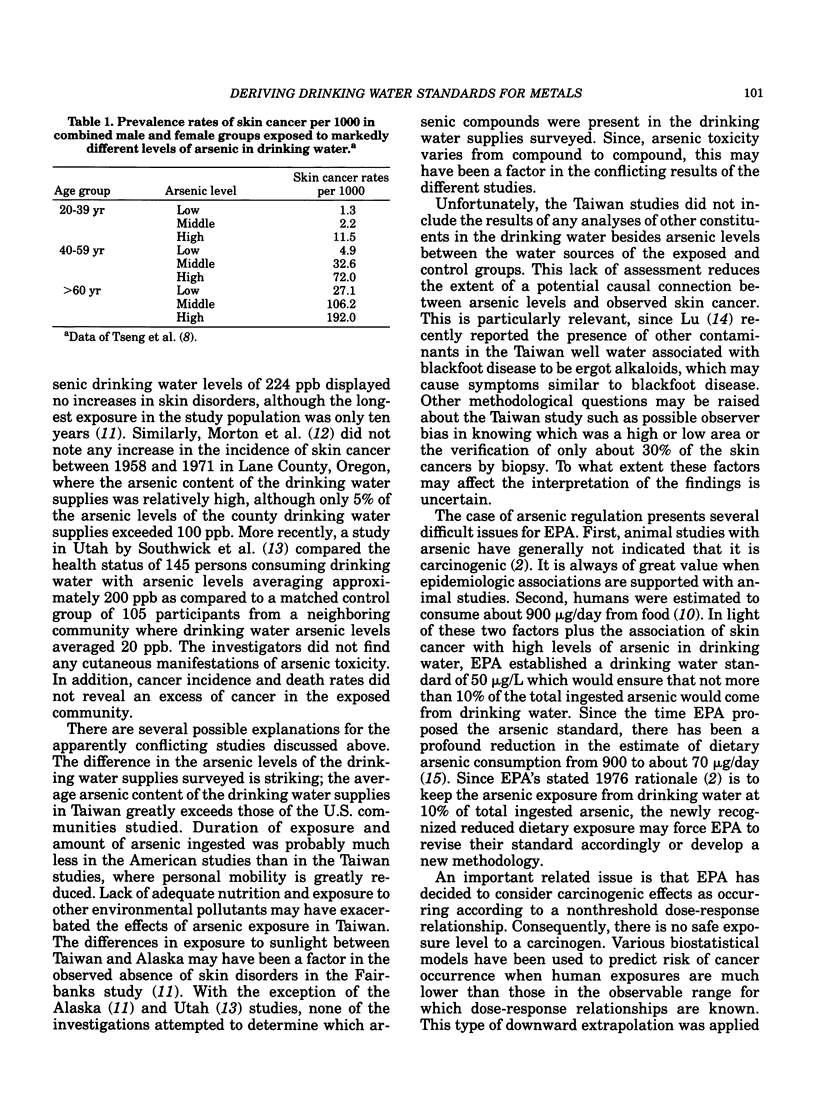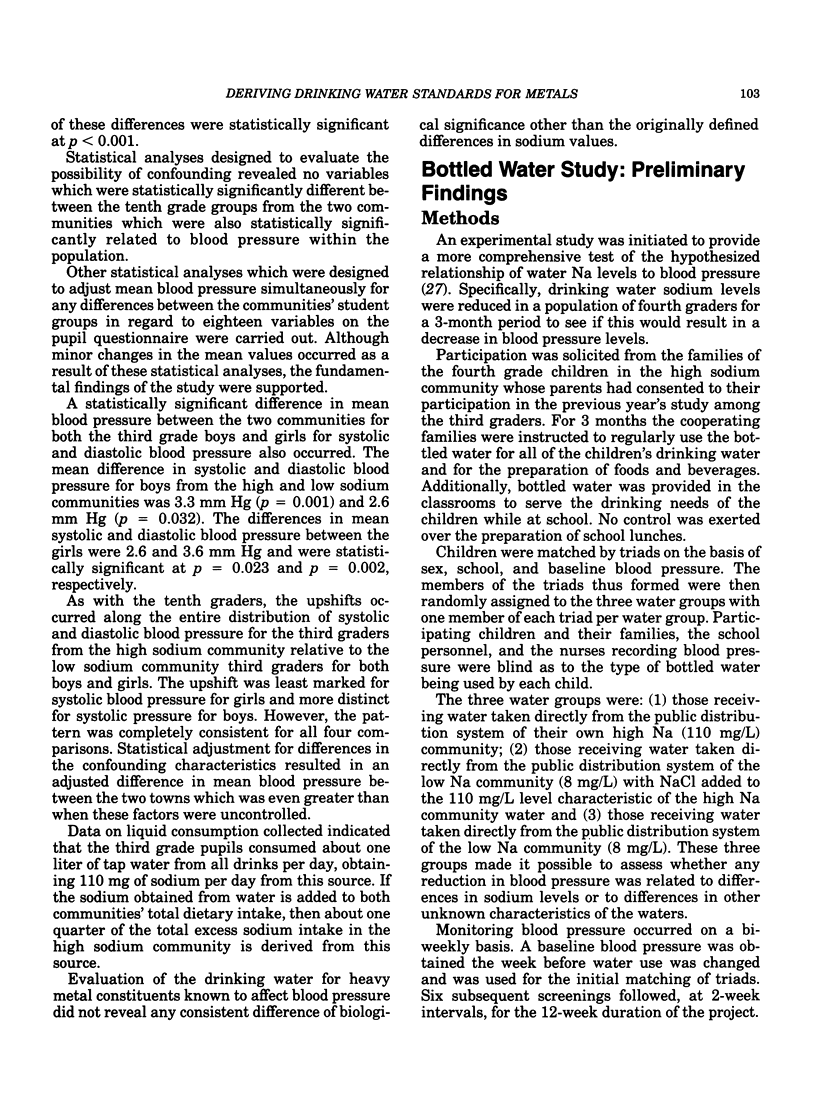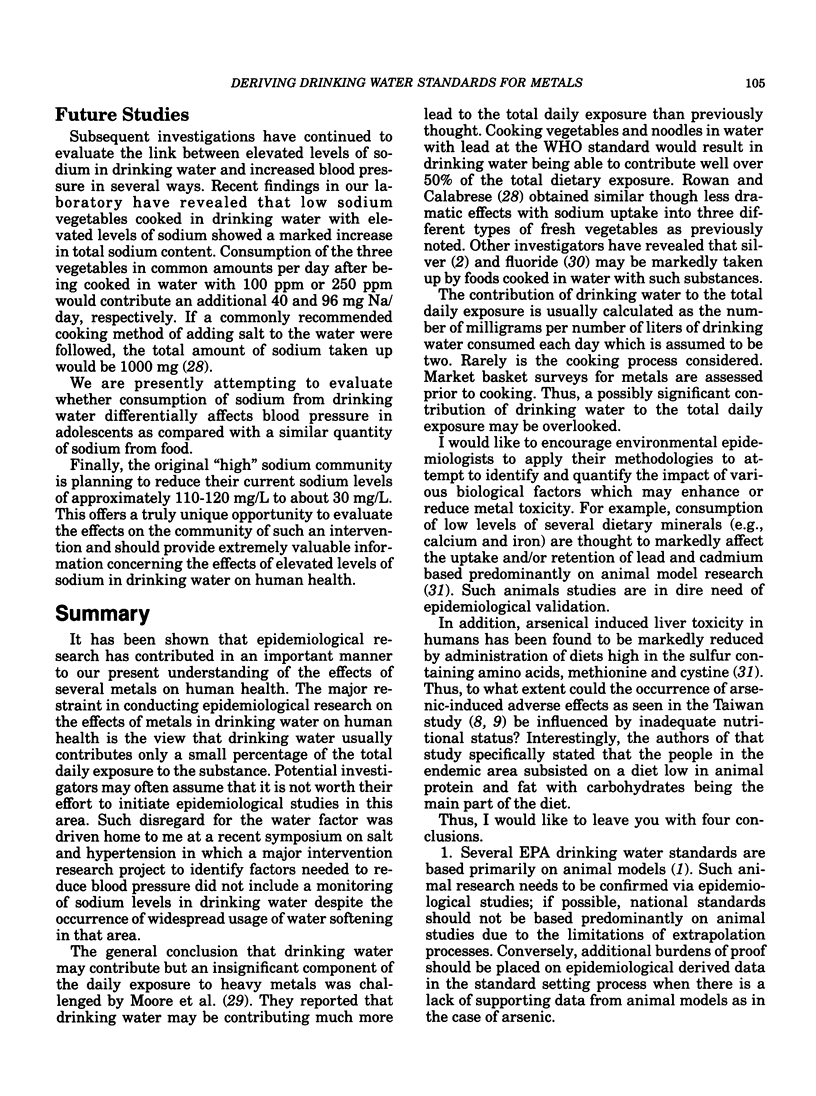Abstract
Epidemiological investigations are shown to have contributed in a significant way to our understanding of the potential adverse health effects of drinking water with elevated levels of several metals. Particular emphasis is given to an assessment of the epidemiological investigations concerned with characterizing the health effects of exposure to elevated levels of arsenic and sodium in drinking water.
Full text
PDF







Selected References
These references are in PubMed. This may not be the complete list of references from this article.
- Borgoño J. M., Vicent P., Venturino H., Infante A. Arsenic in the drinking water of the city of Antofagasta: epidemiological and clinical study before and after the installation of a treatment plant. Environ Health Perspect. 1977 Aug;19:103–105. doi: 10.1289/ehp.19-1637404. [DOI] [PMC free article] [PubMed] [Google Scholar]
- Calabrese E. J., Tuthill E. W. Elevated blood pressure and high sodium levels in the public drinking water. Preliminary results of a study of high school students. Arch Environ Health. 1977 Sep-Oct;32(5):200–202. doi: 10.1080/00039896.1977.10667281. [DOI] [PubMed] [Google Scholar]
- Calabrese E. J., Tuthill R. W. The influence of elevated levels of sodium in drinking water on elementary and high school students in Massachusetts. J Environ Pathol Toxicol. 1980 Sep;4(2-3):151–165. [PubMed] [Google Scholar]
- Harrington J. M., Middaugh J. P., Morse D. L., Housworth J. A survey of a population exposed to high concentrations of arsenic in well water in Fairbanks, Alaska. Am J Epidemiol. 1978 Nov;108(5):377–385. doi: 10.1093/oxfordjournals.aje.a112635. [DOI] [PubMed] [Google Scholar]
- MARTIN D. J. The Evanston Dental Caries Study. VIII. Fluorine content of vegetables cooked in fluorine containing waters. J Dent Res. 1951 Oct;30(5):676–681. doi: 10.1177/00220345510300051101. [DOI] [PubMed] [Google Scholar]
- Moore M. R., Hughes M. A., Goldberg D. J. Lead absorption in man from dietary sources. The effect of cooking upon lead concentrations of certain foods and beverages. Int Arch Occup Environ Health. 1979 Sep;44(2):81–90. doi: 10.1007/BF00386741. [DOI] [PubMed] [Google Scholar]
- Morton W., Starr G., Pohl D., Stoner J., Wagner S., Weswig D. Skin cancer and water arsenic in Lane County, Oregon. Cancer. 1976 May;37(5):2523–2532. doi: 10.1002/1097-0142(197605)37:5<2523::aid-cncr2820370545>3.0.co;2-b. [DOI] [PubMed] [Google Scholar]
- Schroeder H. A., Balassa J. J. Abnormal trace metals in man: arsenic. J Chronic Dis. 1966 Jan;19(1):85–106. doi: 10.1016/0021-9681(66)90152-4. [DOI] [PubMed] [Google Scholar]
- Schroeder H. A. The role of trace elements in cardiovascular diseases. Med Clin North Am. 1974 Mar;58(2):381–396. doi: 10.1016/s0025-7125(16)32164-2. [DOI] [PubMed] [Google Scholar]
- Tseng W. P., Chu H. M., How S. W., Fong J. M., Lin C. S., Yeh S. Prevalence of skin cancer in an endemic area of chronic arsenicism in Taiwan. J Natl Cancer Inst. 1968 Mar;40(3):453–463. [PubMed] [Google Scholar]
- Tseng W. P. Effects and dose--response relationships of skin cancer and blackfoot disease with arsenic. Environ Health Perspect. 1977 Aug;19:109–119. doi: 10.1289/ehp.7719109. [DOI] [PMC free article] [PubMed] [Google Scholar]
- Tuthill R. W., Calabrese E. J. Elevated sodium levels in the public drinking water as a contributor to elevated blood pressure levels in the community. Arch Environ Health. 1979 Jul-Aug;34(4):197–203. doi: 10.1080/00039896.1979.10667398. [DOI] [PubMed] [Google Scholar]
- Zaldívar R. Arsenic contamination of drinking water and foodstuffs causing endemic chronic poisoning. Beitr Pathol. 1974 Apr;151(4):384–400. doi: 10.1016/s0005-8165(74)80047-8. [DOI] [PubMed] [Google Scholar]


